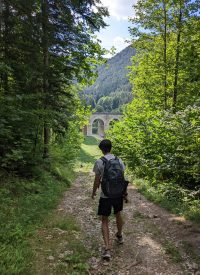Surviving a Heatwave with Sustainable Design – Quinton Frederick ’23

Vienna wasn’t supposed to be so hot. I studied abroad in Austria’s capital for four weeks this summer during a record breaking heatwave. Most days, the average temperature was ten degrees above the typical summer average. Sometimes it was even more. I never wore the long-sleeved t-shirts that took up valuable room in my carry-on. Along with most of the city, I spent my free time eating ice cream or swimming in the Danube to cool off. For those four sweltering weeks I lived in a student dorm without air conditioning, fans, or even ice cubes. Here comes the surprising part though: my dorm in Vienna felt just as cool and comfortable as my air-conditioned Charlotte apartment.
I traveled to Vienna to study passive houses. Passive houses are a sustainability standard which uses efficient design strategies to reduce energy consumption in buildings. Austria has thousands of passive house certified buildings, including my dorm, which use almost no energy over the course of a year. This explains why I was so comfortable in my room, even during a historic heat wave. Sun shades, cross ventilation, and extra insulation kept the building cool instead of power hungry AC units. During the day I attended lectures, field trips, and workshops that taught me how to design sustainable, energy efficient buildings. At night, I learned how these building’s functioned firsthand by living in one. 
The building sector is responsible for around fifty percent of the world’s carbon emissions every year. Building operations like lighting, heating and cooling alone contribute as much as transportation. Future architects have a responsibility to combat this alarming statistic. Thoughtful design can dramatically reduce the environmental impact of our new and existing buildings. Sustainable strategies like the use of daylighting and ventilation also improve our comfort in the spaces where we live and work. After all, who doesn’t love a cool breeze from an open window? As extreme weather events like heat waves become more common, these strategies will become even more valuable.
This summer showed me that I can contribute to this important work and completely transformed my future plans and my ideas about architecture. I already knew that sustainable design was important, but this summer I found out that it’s also fun! I can’t wait to get started.